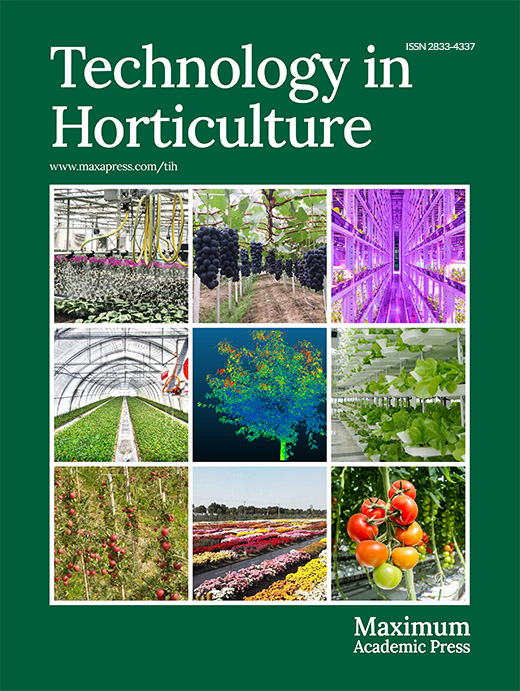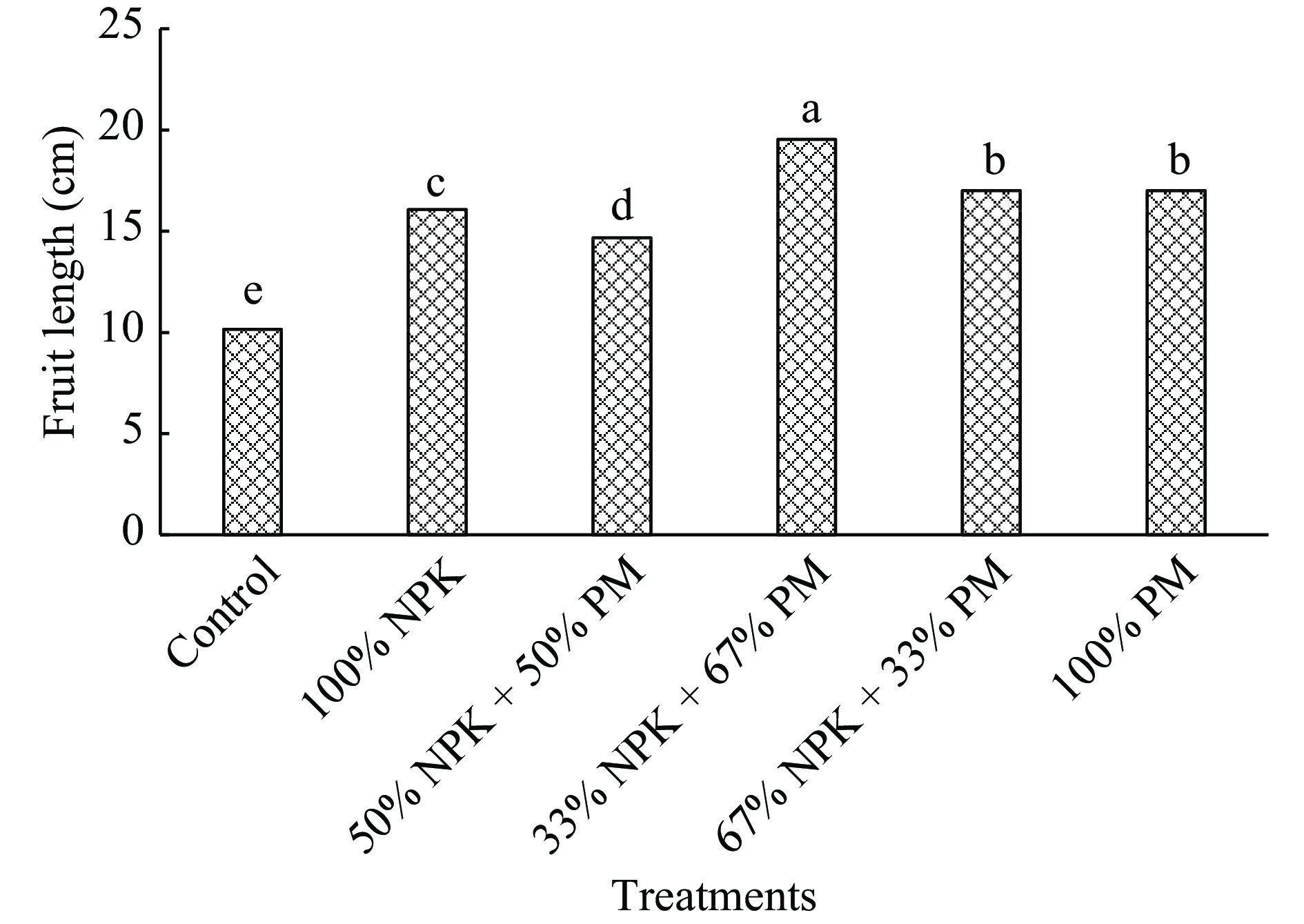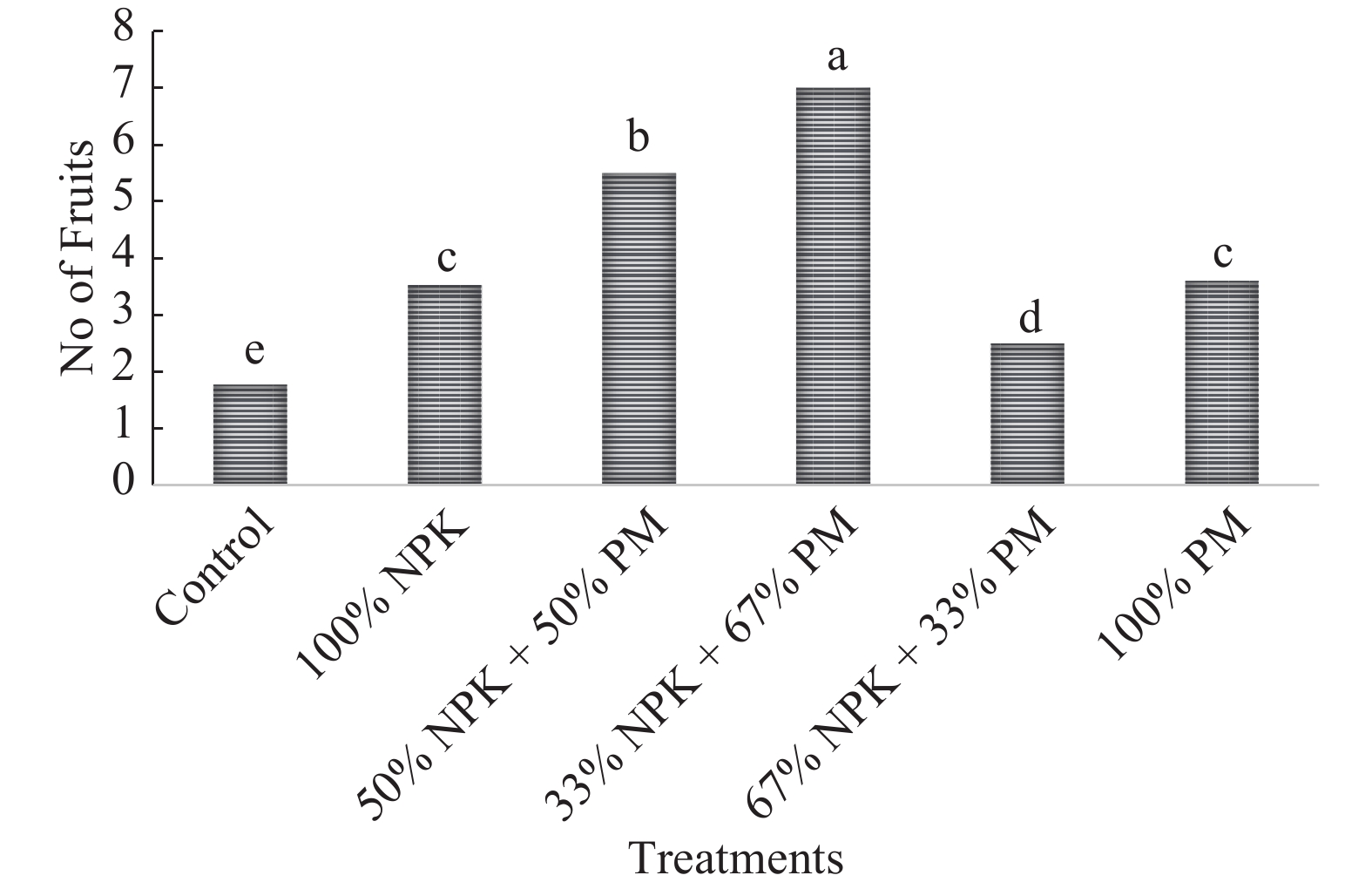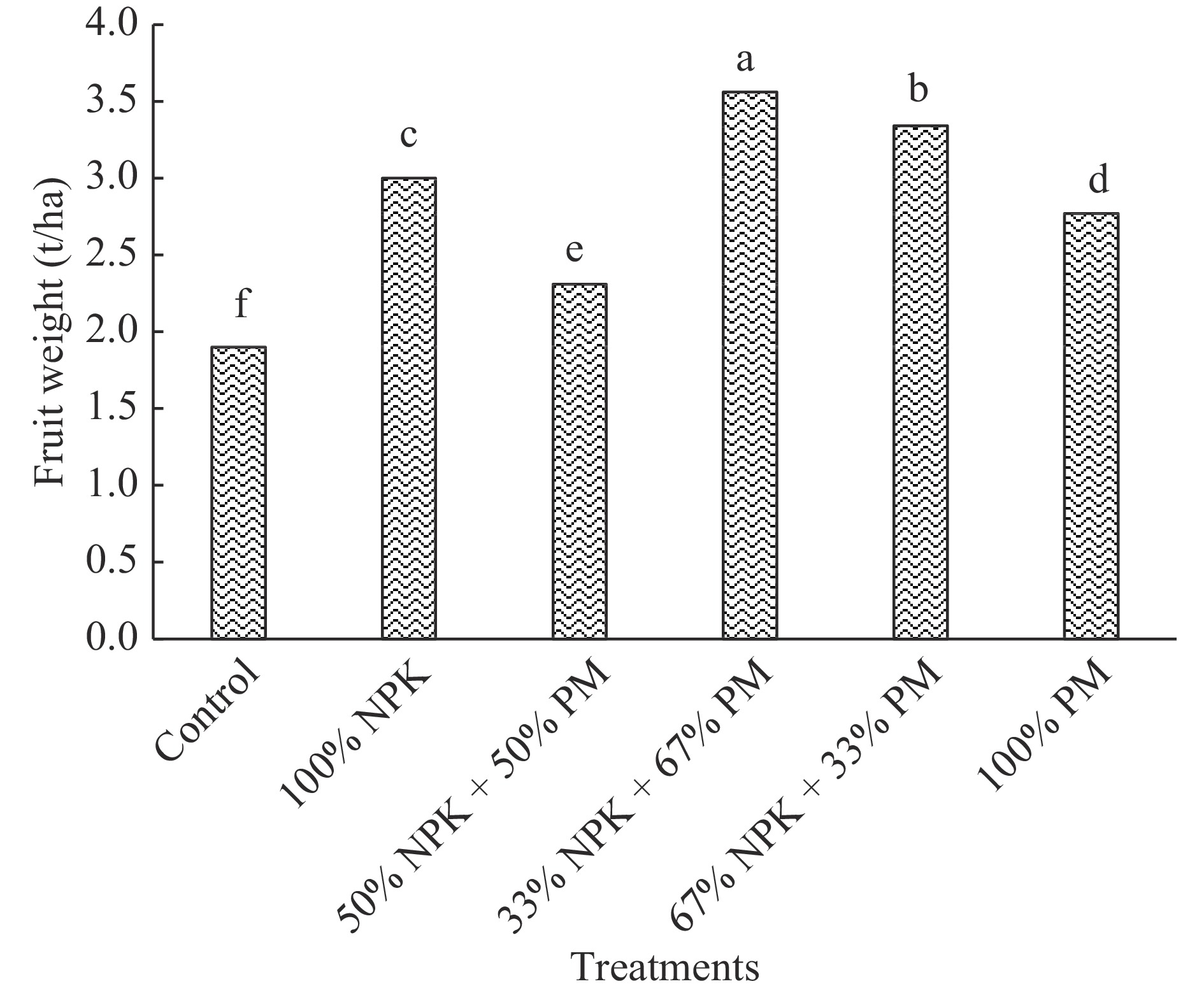-
Pepper is an important fruit vegetable as it is the second most cultivated vegetable world-wide after tomatoes. It has increased in popularity, thus becoming an indispensable part of the daily diet of millions of Nigerians[1]. Bell pepper (Capsicum annuum L.) is a rich source of vitamins and minerals which are essential food supplements for healthy human nutrition. Pepper is rich in vitamins A, B6, C, E, K, trace elements such as copper, iron, manganese and potassium, ascorbic acid, flavonoids, oligosaccharides and carotenoid compounds[2]. Considering the nutritional values and benefits attributable to pepper consumption which has made it significant to the healthy living of human beings, it has thus become essential in many homes across Nigeria and the world at large.
The world population is expected to grow by over a third, or 2.3 billion people between 2009 and 2050[3]. In view of this, there is the need to boost food production to meet the demand. Pepper production continues to increase in Nigeria due to the rising demand for the produce. Pepper is widely cultivated throughout Nigeria[4], yields obtained by peasant farmers are often very low. Production is limited by low availability of soil nutrients, pest and disease incidence, moisture stress, weed interference, these hinder optimum growth and yield of pepper where poor soil fertility forms a key contributory factor. Optimum crop production essentially requires adequate supply of nutrients.
Fertilizers (organic or inorganic) are necessary to supplement for one or more nutrients essential for plant growth and development. An assessment revealed that about 40%−60% of crop yields are attributable to commercial fertilizer use[5]. Mineral fertilizers have been used conventionally to enhance crop production, however, continuous use and at high rates may hamper soil performance. Moreover, due to high cost and scarcity, most farmers find it difficult to afford the use of chemical fertilizer, this has necessitated research into organic wastes that are cheap, readily available and environmentally friendly and can be used as substitutes[6]. Organic fertilizers such as poultry manure can be used to complement inorganic fertilizers in order to circumvent the risks attributable to sole use of inorganic fertilizer for crop production. The objective of this study was therefore to assess the response of bell pepper in terms of growth and yield to different combination ratios of poultry manure and NPK.
-
The field experiment was carried out at a research farm of the Department of Agronomy, University of Ibadan, Nigeria (Latitude 7°24' N, Longitude 3°54' E and Altitude 234 m above sea level). The experimental plot was cleared manually, five soil samples were collected (at 0−15 cm depth) with the use of soil auger from different parts of the field and were bulked together to form a composite sample. Soils were air-dried and crushed to pass through 2 and 0.5 mm sieves. Routine soil analysis was carried out to determine physical and chemical properties which include soil pH, organic carbon, total nitrogen, available phosphorous, exchangeable cations (potassium, magnesium, calcium, and sodium), exchangeable acidity, micronutrients (iron, manganese, copper, and zinc). Particle size analysis (silt, sand and clay) was also determined using the Boyoucous hydrometer method.
Experimental design
-
The treatments consisted of different proportions of NPK 15:15:15 and cured PM collected from the Teaching and Research Farm of the University applied at the rate of 250 kg/ha of NPK 15:15:15[1] and 15 t/ha of PM[7]. PM was applied 2 weeks before transplanting while NPK 15:15:15 was applied at 2 Weeks After Transplanting (WAT) using the ring method. The treatments were combined into one factor (T1 = Control (No fertilizer), T2 = 100% NPK, T3 = 50% NPK + 50% PM, T4 = 33% NPK + 67% PM, T5 = 67% NPK + 33% PM, T6 = 100% PM) and laid out in a randomized complete block design (RCBD). Plot size was 1.2 m × 0.9 m (1.08 m2) with 0.5 m spacing between beds and 1 m between replicates. There were six beds per replicate and the experiment had four replicates, making the total experimental area to be 66.3 m2. Transplanting was done at spacing of 30 cm × 60 cm making the plant population per bed to be 12 corresponding to population of 55,555 plants per hectare.
Agronomic practices
-
Bell pepper seeds (Yolowonder variety) were sown into nursery trays containing rich top soil. Transplanting of young vigorous seedlings (with 8−10 leaves) to the field was done at 5 weeks after sowing (5WAS). Weed control was carried out at three week interval using a hoe. Twenty-four litres of water was used to irrigate each bed after transplanting of seedlings using watering can, this was carried out three times a week for eight weeks after transplanting. Insecticide (Cyperforce a.i. Cypermethrin 10% E.C) was applied once at 40 mL in 20 L of water to control insect pests at 4 weeks after transplanting when insects were observed on the plants.
Data collection and analysis
-
Five plants out of 12 plants per bed were randomly sampled and tagged for data collection on plant height (cm), stem diameter (cm), number of leaves and number of branches (at 3, 4, 5 and 6 WAT). Plant height was measured with the aid of a meter rule while digital venier caliper was used to determine stem diameter, number of leaves and number of branches were obtained by counting. Number of fruits per plant was also determined by counting, fresh fruit weight (g) was determined with the use of weighing scale while fruit length (cm) was measured with a meter rule. Data collected were subjected to analysis of variance (ANOVA) and significant means separated using Duncan Multiple Range Test (DMRT) at p < 0.05.
Results
-
The soil analysis of the experimental site prior to cropping was slightly acidic, sandy loam, low in total nitrogen, exchangeable magnesium and available phosphorous while exchangeable potassium and calcium were marginal (Table 1). The chemical analysis of the poultry manure (Table 1) shows the presence of high organic matter with more nitrogen and calcium than potassium and magnesium. The low nitrogen and phosphorous of the soil are expected to benefit from the application of poultry manure. Results of the effects of PM and NPK fertilizer on height (cm) of bell pepper as shown in Table 2 revealed that bell pepper height increased from 3 to 6 WAT across all the treatments. Furthermore at 6 WAT, plants treated with 33% NPK + 67% PM had significantly (p < 0.05) higher height than those with other treatments and control.
Table 1. Chemical properties, particle size of experimental soil and poultry manure composition.
Properties Soil Poultry manure pH (H2O) 6.6 8.2 Organic carbon (g/kg) 15.6 Organic matter (g/kg) 700 Total N (g/kg) 1.7 49.8 Available P (mg/kg) 10 0.3 Exchangeable cations (cmol/kg) Magnesium 0.7 4.7 Calcium 1.8 34.5 Potassium 0.3 3.5 Sodium 0.8 0.8 Exchangeable acidity (cmol/kg) 0.2 Extractible micronutrients (mg/kg) Iron 78.8 3870 Manganese 109.6 450 Copper 1.4 24.9 Zinc 8.6 310 Sand (g/kg) 812 Silt (g/kg) 54 Clay (g/kg) 134 Textural class (USDA) Sandy loam Table 2. Effects of poultry manure and NPK fertilizer on plant height (cm) of bell pepper.
Treatments 3 WAT 4 WAT 5 WAT 6 WAT Control 11.66b 12.72c 13.35c 15.00e 100% NPK 10.15d 11.44d 13.69c 16.31d 50% NPK + 50% PM 11.19c 12.61c 15.29b 17.50c 33% NPK + 67% PM 21.79a 26.89a 27.68a 30.26a 67% NPK + 33% PM 11.00b 12.38c 13.76c 17.44c 100% PM 10.27d 13.34b 15.01b 19.63b F value 1,857.61 8,696.36 2,896.06 3,668.11 Pr > F <0.0001 ** <0.0001 ** <0.0001 ** <0.0001 ** Different letters within the same column indicate a significant difference at p < 0.05, ** significance at p ≤ 0.01, PM = Poultry Manure, WAT = Week After Transplanting. Effects of PM and NPK fertilizer on stem diameter of bell pepper as presented in Table 3 showed that plants treated with 33% NPK + 67% PM had the highest stem diameter at 6 WAT, in addition, plants treated with 100% PM, 100% NPK and 50% NPK + 50% PM had higher stem diameter than the control (Table 3). Results of this experiment further showed that application of varying proportion of PM and NPK fertilizer had significant effect on number of leaves of bell pepper from 3 to 6 WAT. Bell pepper with no fertilizer application (i.e. control) had higher number of leaves at 3 and 4 WAT while at 5 and 6 WAT, application of 33% NPK + 67% PM resulted in significantly (p < 0.05) higher number of leaves than other treatments (Table 4).
Table 3. Effects of poultry manure and NPK fertilizer on stem diameter (cm) of bell pepper.
Treatments 3 WAT 4 WAT 5 WAT 6 WAT Control 0.40 0.44 0.42 0.45f 100% NPK 0.32 0.35 0.42 0.58d 50% NPK + 50% PM 0.38 0.41 0.47 0.65c 33% NPK + 67% PM 0.50 0.48 0.57 0.94a 67% NPK + 33% PM 0.33 0.40 0.46 0.50e 100% PM 0.38 0.36 0.52 0.70b F value 0.85 0.80 0.95 643.18 Pr > F 0.5363ns 0.5670ns 0.4796ns <0.0001** Different letters within the same column indicate a significant difference at p < 0.05, ** significance at p ≤ 0.01, ns = not significant, PM = Poultry Manure, WAT = Week After Transplanting. Table 4. Effects of poultry manure and NPK fertilizer on number of leaves of bell pepper.
Treatments 3 WAT 4 WAT 5 WAT 6 WAT Control 13.00a 15.20a 23.75b 24.20c 100% NPK 8.20c 9.80d 12.75d 21.80e 50% NPK + 50% PM 8.50c 10.00c 12.25e 20.20f 33% NPK + 67% PM 12.80b 13.80b 28.50a 43.20a 67% NPK + 33% PM 7.50d 8.50f 11.50f 23.20d 100% PM 7.20e 9.00e 14.25c 30.50b F value 4,344.76 4,263.35 56,591.40 71,146.60 Pr > F <0.0001** <0.0001** <0.0001** <0.0001** Different letters within the same column indicate a significant difference at p < 0.05, ** significance at p ≤ 0.01, PM = Poultry Manure, WAT = Week After Transplanting. Application of PM and NPK had significant effect on number of branches of bell pepper by significantly increasing number of branches throughout the period of observation (i.e. 3 to 6 WAT). Application of 33% NPK + 67% PM produced significantly (p < 0.05) higher number of branches of bell pepper (Table 5). Moreover, among the treatments, application of 33% NPK + 67% PM produced significantly longer fruits of 19.54 cm, higher number of fruits per plant (7) and higher fruit weight of 3.56 t/ha while the shortest fruits (10.15 cm), least number of fruits per plant (2) and least fruit weight of 1.9 t/ha were obtained from the control plot which is no fertilizer (Figs 1−3)
Table 5. Effects of poultry manure and NPK fertilizer on number of branches of bell pepper.
Treatments 3 WAT 4 WAT 5 WAT 6 WAT Control 0.75b 1.25b 2.25d 3.50f 100% NPK 0.25c 0.75d 1.75e 6.75c 50% NPK + 50% PM 0.25c 0.75d 2.50c 5.00e 33% NPK + 67% PM 1.25a 3.75a 9.00a 10.00a 67% NPK + 33% PM 0.00d 0.50e 1.75e 5.75d 100% PM 0.00d 1.00c 3.50b 8.00b F value 6,045.82 81,663.60 94,803.10 6,776.91 Pr > F <0.0001** <0.0001** <0.0001** <0.0001** Different letters within the same column indicate a significant difference at p < 0.05, ** significance at p ≤ 0.01, PM = Poultry Manure, WAT = Week After Transplanting. -
In general, application of poultry manure and NPK fertilizers increased growth and yield of pepper as indicated by plant height, number of leaves, number of branches, stem diameter, number of fruits per plant and fruit weight. This result is consistent with the study by Adesina et al.[8] who reported that application of manure increased pepper yield and production. This could be attributable to the increased availability of nutrients in the soil as supplied by the different fertilizers added. The findings that sole application of NPK and Organo-mineral fertilizers and their various combinations improved the growth parameters of pepper[1] also support the result of this experiment. Furthermore, results of this study corroborates the findings that the use of 10 t/ha goat manure and 250 kg/ha NPK 15:15:15 enhanced growth and fruit yield of pepper, plant height, number of leaves, number of branches, stem girth, number and weight of fruits increased with an increase in application of goat manure as a result of improved availability of nutrients from the animal manure[9].
The evidence from this study showed that application of high levels of organic manure combined with low quantities of mineral fertilizer gave better performance of pepper. This could be attributed to the fact that organic manure complements mineral fertilizers by supplying both mineral nutrients and organic matter. N, P and K fertilizers were more efficient than the organic manures in supplying N, P and K to the growing plant at least in the short run[10]. This explains why there was a higher initial number of leaves and branches observed for plants that received 100% NPK alone at 250 kg/ha as compared with those receiving 100% PM solely at 15 t/ha. This may be attributed to quick release of nitrogen, phosphorous and potassium from mineral fertilizer than in the poultry manure[11]. However, poultry manure has been reported to increase supply of phosphorous and potassium to the soil as well as nitrogen which gives strong plant growth and fruit yield[12]. Hence, plants that received 100% PM solely, later recorded a higher number of leaves and branches at 6 WAT, although not significantly higher than the control which may be adduced to the native nutrient present in the soil which is marginal to support pepper growth. Effect of inorganic fertilizers was significantly lower when compared to poultry manure in the production of lettuce which could be linked with the lower esteem in moisture retention as well as poor characteristics in soil particle aggregation of inorganic fertilizers[13] cited by Masarirambi et al.[14]. They added that although, inorganic fertilizers are easy to apply and are quickly absorbed and utilized by crops, in the long run they tend to destroy the soil structure if not used carefully, thereby increasing costs of production and reduction of profit in crop production enterprises.
In terms of yield, plants that received 33% NPK + 67% PM performed significantly better than other treatments and produced fruit yield of 3.6 t/ha which was significantly higher than the control (1.9 t/ha). This supports the findings that vegetables grown with higher levels of organic manure performed better and resulted in a final higher total yield than those grown with lower amounts or those grown using synthetic fertilizers alone[15]. Also, application of animal manure has been reported to enhance yield of vegetable crops such as okra, amaranths etc.[16]. Animal manure also has beneficial effects on soil physical and chemical properties[17] as well as the ability to supply macro and trace elements that are not contained in inorganic fertilizers[18]. Generally, fresh fruit yield from this study ranged from 1.9−3.6 t/ha, this shows better performance in that it exceeds the African average yield of 1.00 t/ha[19].
-
It is evident from the results of this study that bell pepper benefited from the plant nutrients supplied in the fertilizers applied. A higher level of poultry manure in combination with lower level of NPK fertilizer (33% NPK + 67% PM) had the best performance in terms of growth and yield of bell pepper and therefore can be recommended.
-
The authors confirm contribution to the paper as follows: study conception and design: Hassan OA, Babatola LA; data collection: Hassan OA; analysis and interpretation of results: Ajayi EO, Hassan OA; draft manuscript preparation: Ajayi EO, Hassan OA. All authors reviewed the results and approved the final version of the manuscript.
-
The datasets generated during and/or analyzed during this study are available from the corresponding author on reasonable request.
-
The authors wish to appreciate the Department of Agronomy, University of Ibadan for providing the facilities to carry out this study.
-
The authors declare that they have no conflict of interest.
- Copyright: © 2024 by the author(s). Published by Maximum Academic Press, Fayetteville, GA. This article is an open access article distributed under Creative Commons Attribution License (CC BY 4.0), visit https://creativecommons.org/licenses/by/4.0/.
-
About this article
Cite this article
Hassan OA, Ajayi EO, Babatola LA. 2024. Growth and yield of bell pepper as influenced by combination of poultry manure and NPK fertilizer. Technology in Horticulture 4: e010 doi: 10.48130/tihort-0024-0007
Growth and yield of bell pepper as influenced by combination of poultry manure and NPK fertilizer
- Received: 21 July 2023
- Revised: 18 February 2024
- Accepted: 04 March 2024
- Published online: 08 May 2024
Abstract: A field experiment was carried out to assess the growth and yield of bell pepper to different combination ratios of Poultry Manure (PM) and NPK 15:15:15. The experiment was carried out at a research farm of the Department of Agronomy, University of Ibadan, Nigeria. The treatments, consisting of Control (no fertilizer), 100% NPK, 50% NPK + 50% PM, 33% NPK + 67% PM, 67% NPK + 33% PM and 100% PM were laid out in a randomized complete block design (RCBD) with four replications. Five plants from the same treatment were randomly sampled out of 12 plants per bed and tagged for data collection on growth parameters at 3, 4, 5 and 6 weeks after transplanting as well as number of fruits, fruit length and fruit yield. Data collected were subjected to analysis of variance (ANOVA) and significant means separated using Duncan Multiple Range Test (DMRT) at p < 0.05. Results from this study revealed that plants with application of 33% NPK + 67% PM were significantly (p < 0.05) taller and had more leaves and branches than other treatments and control. Likewise, plants which received 33% NPK + 67% PM treatment had significantly higher fruit yield than control and other treatments. It can therefore be concluded that a high level of poultry manure in combination with lower level of NPK (33% NPK + 67% PM) had the best performance in terms of growth and fruit yield of bell pepper and is therefore recommended.
-
Key words:
- Growth /
- Poultry manure /
- Organic fertilizer /
- Inorganic fertilizer /
- Fruit yield















